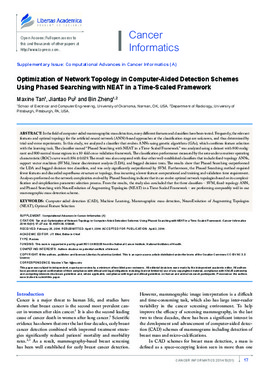| dc.description.abstract | In the field of computer-aided mammographic mass detection, many different features and classifiers have been tested. Frequently, the relevant features and optimal topology for the artificial neural network (ANN)-based approaches at the classification stage are unknown, and thus determined by trial-and-error experiments. In this study, we analyzed a classifier that evolves ANNs using genetic algorithms (GAs), which combines feature selection with the learning task. The classifier named “Phased Searching with NEAT in a Time-Scaled Framework” was analyzed using a dataset with 800 malig-nant and 800 normal tissue regions in a 10-fold cross-validation framework. The classification performance measured by the area under a receiver operating characteristic (ROC) curve was 0.856 ± 0.029. The result was also compared with four other well-established classifiers that include fixed-topology ANNs, support vector machines (SVMs), linear discriminant analysis (LDA), and bagged decision trees. The results show that Phased Searching outperformed the LDA and bagged decision tree classifiers, and was only significantly outperformed by SVM. Furthermore, the Phased Searching method required fewer features and discarded superfluous structure or topology, thus incurring a lower feature computational and training and validation time requirement. Analyses performed on the network complexities evolved by Phased Searching indicate that it can evolve optimal network topologies based on its complexi-fication and simplification parameter selection process. From the results, the study also concluded that the three classifiers – SVM, fixed-topology ANN, and Phased Searching with NeuroEvolution of Augmenting Topologies (NEAT) in a Time-Scaled Framework – are performing comparably well in our mammographic mass detection scheme. | en_US |
